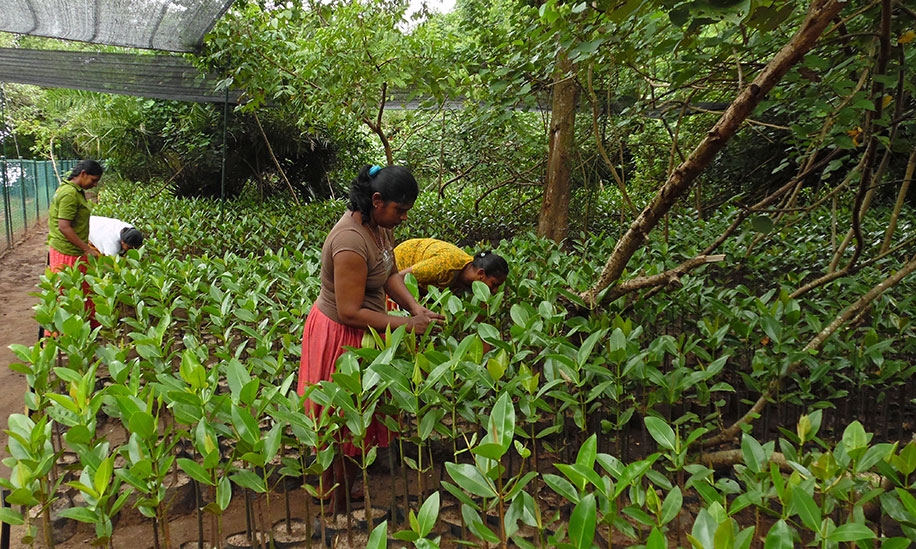Along South Asia’s (SA) coasts, recent population growth, land subsidence and habitat degradation have increased the risk of coastal floods (Vinke et al., 2017). This risk is expected to be further heightened by projected increases in sea-level and storm frequency. By 2030, 225 million people are estimated to reside in SA’s low-elevation coastal zones, making the need for coastal flood management greater than ever (Neumann et al., 2015).
In the past, coastal flood management in SA has typically involved the construction of dams, dykes and seawalls (Brears, 2015). Recently, however, more nature-based flood control measures have been implemented, such as mangrove forest restoration and preservation (Kodikara et al., 2017). Mangrove forests—which consist of trees and shrubs adapted to marine environments—protect coastal communities from flooding through wave-attenuation (NOAA, 2017)
Leading SA’s mangrove restoration efforts is Sri Lanka, which adapted the flood control measure in wake of the 2004 Indian Ocean Tsunami (Kodikara et al., 2017). Over 60 mangrove conservation initiatives have been launched in the recent 15 years—the most successful of which is the Sri Lanka Mangrove Conservation Project (SLMCP).
The SLMCP began in 2015, following a partnership agreement between Sudeesa (a Sri Lankan NGO), Seacology (an American non-profit organization) and the Sri Lanka government (Wickramasinghe, 2017). In this agreement, the 3 partners committed 5-years to protecting all 8,815 hectares of Sri Lanka’s existing mangrove forests and replanting an additional 3,885 hectares using nursery-raised mangrove seedlings (Seacology, n.d.).

Women caring for mangrove seedlings as part of the Sri Lanka Mangrove Conservation Project.
Sudeesa and Seacology have contributed towards the SLMCP’s goals by setting up an incentive program directed at impoverished women and youth in small coastal communities. In this program, participants attend mangrove conservation workshops and commit to restoring and protecting their local mangrove forests (Wickramasinghe, 2017). In exchange, participants receive alternative job training and microloans to develop or expand their own sustainable businesses. As of 2017, the program has provided 7,900 women and youth with alternative job training and 2,893 women with microloans. In exchange, these women and youth are protecting over 5500 hectares of mangrove forest and have planted over 700,000 mangrove seedlings (UNFCCC, n.d.). To see this program in action, check out the following video:
The Sri Lankan government has contributed towards the goals of the SLMCP through legislation and regulation (Wickramasinghe, 2017). For example, the Sri Lanka government has provided legal protection for all national mangrove forests as well as rangers to patrol the mangroves and enforce protection. In addition, the government has demarcated and gazetted roughly 21 hectares of mangrove forest to each coastal community participating in the incentive program (UNFCCC, n.d.).
Despite a 5-year timeframe, the SLMCP will have life-long societal and ecological benefits for Sri Lanka. Stable mangrove forests will help protect coastal communities from flooding and provide habitat for a large diversity of marine and terrestrial life. Furthermore, provision of sustainable livelihoods will improve residents’ quality of life and minimize future mangrove exploitation.
References
Brears, R. (2015). Integrated Flood Risk Management in India and the South Asia region: Lessons from the Rhine and Danube (NFG Policy Paper No. 8.2015). Berlin, Germany: NFG Publications.
Kodikara, K. A. S., Mukherjee, N., Jayatissa, L. P., Dahdouh‐Guebas, F., & Koedam, N. (2017). Have mangrove restoration projects worked? An in‐depth study in Sri Lanka. Restoration Ecology, 25(5), 705-716.
National Oceanic and Atmospheric Administration (NOAA). (2017). Mangrove Forests. Retrieved February 9th from https://oceanservice.noaa.gov/education/kits/estuaries/media/supp_estuar06b_mangrove.html
Neumann, B., Vafeidis, A. T., Zimmermann, J., & Nicholls, R. J. (2015). Future coastal population growth and exposure to sea-level rise and coastal flooding-a global assessment. PloS one, 10(3), e0118571.
Seacology. (n.d.). Sri Lanka Mangrove Conservation Project. Retrieved February 9th from https://www.seacology.org/project/sri-lanka-mangrove-conservation-project/
United Nations Framework Convention on Climate Change (UNFCCC). (n.d.). Sri Lanka Mangrove Conservation Project – Sri Lanka. Retrieved February 9th from https://unfccc.int/climate-action/momentum-for-change/planetary-health/sri-lanka-mangrove-conservation-project
Vinke, K., Martin, M. A., Adams, S., Baarsch, F., Bondeau, A., Coumou, D., Donner, R.V., Menon, A., Perrette, M., Rehfeld, K. & Robinson, A. (2017). Climatic risks and impacts in South Asia: extremes of water scarcity and excess. Regional Environmental Change, 17(6), 1569-1583.
Wickramasinghe, D. (2017). Regreening the Coast: Community-Based Mangrove Conservation and Restoration in Sri Lanka. In Participatory Mangrove Management in a Changing Climate (pp. 161-171). Springer, Tokyo.

